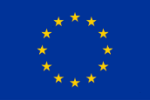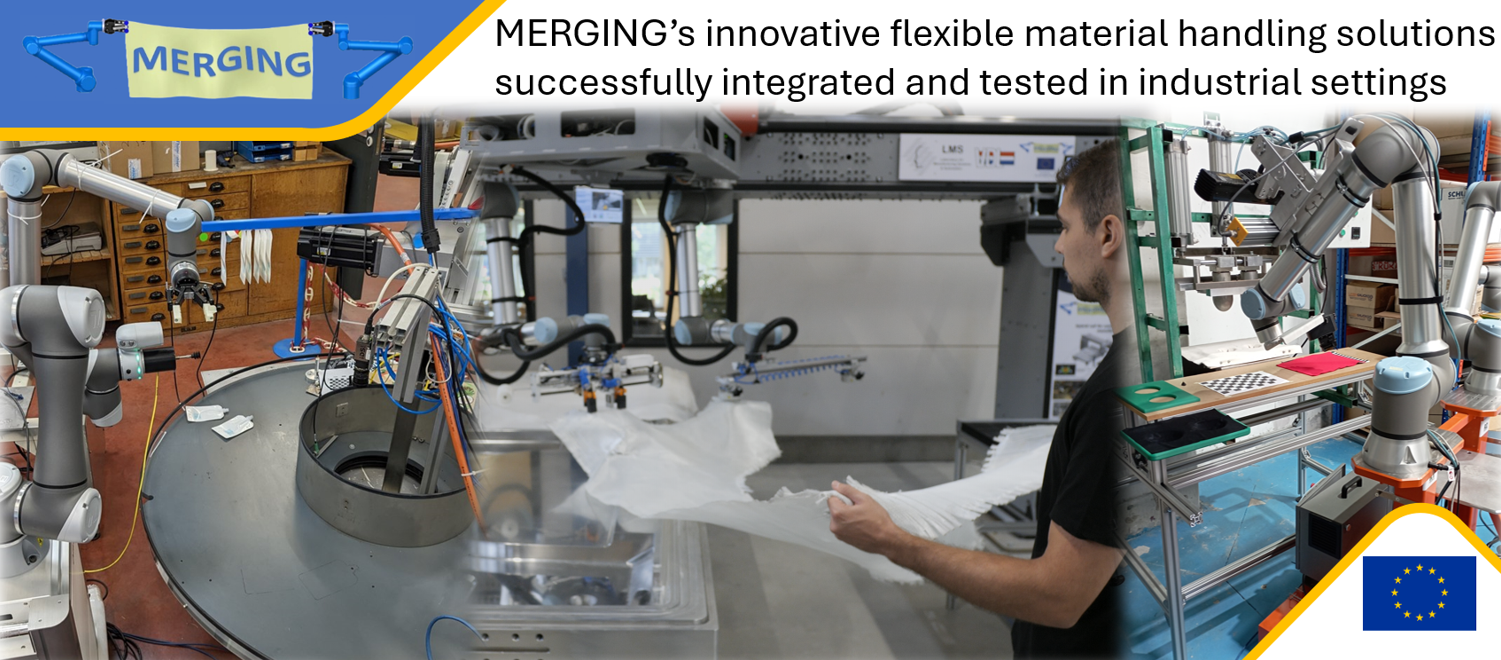Press Release
Building on its prior success, MERGING’s innovations have now been tested on the industrial floors. Together with the project’s integrators, research teams have transitioned the robotic systems from the lab to real-world industrial setups. Comprehensive industrial testing and validation have been successfully completed, marking a milestone for the food packaging, textile, and composite sectors.
The MERGING consortium has successfully transitioned its robotic systems from the lab to the demanding environment of industrial shop floors. The developed robotic solutions, designed to enhance automation in flexible material handling, seamlessly integrate a collection of software and hardware modules that equip robots with advanced capabilities, allowing them to perceive and adapt to deformations in flexible materials and manage their interactions in both autonomous and collaborative settings.
The creation of user-friendly tools for system programming and orchestrating is also considered as an important aspect of the developed technologies. Through intuitive interfaces, activities are directed towards simplifying the integration and use of the developed system in industrial setups.
Key to the project’s success are novel gripping solutions developed by OMNIGRASP, LMS and OPTEAMUM. These tools excel in the handling of a diverse range of materials, from flexible packaging and garments to fiberglass fabrics and composite core materials. In collaboration with LMS, CEA and AIMEN, these solutions pave the way to innovative handling strategies using single or dual-arm robot manipulators. Designed to meet the requirements of industrial tasks, the MERGING solution can either operate in a fully automatic way or collaboratively with human operators, translating their handling intentions into robotic movements.
The outcomes from industrial integration signal the project’s final milestone.
Following the laboratory testing phases, the three setups underwent practical testing in real-world industrial settings, resulting in all consortium partners’ building blocks integration across diverse facilities.
The intermediate setup developed at AIMEN research facilities in Spain, dedicated to the automation of lingerie manufacturing, has been integrated into SELMARK facilities. The design and development activities by the partners were based on specifications from the SELMARK industrial case, and the final solution involves dual-arm manipulation using new electro-adhesive (EA) grippers.
Similarly, a system for the semi-automation of composites manufacturing, initially designed and implemented at LMS facilities in Greece, has been successfully integrated with the partners into the VDL Fibertech facilities. The innovative approach, centered on an overhead dual-arm manipulator, yielded results that reflect the efficiency and precision demanded by this challenging sector.
The robotic setup, originally developed at CEA LIST facilities in France, was successfully integrated with the partners into THIMONNIER facilities. This integration addressed challenges inherent to the flexible materials encountered in food packaging industry. The final solution involves two collaborating robots and the use of a new electro-adhesive (EA) gripper.
Beyond achieving their primary objectives, the demonstrators also provided valuable insights regarding essential MERGING components, highlighting the project’s fundamental results adaptability across diverse sectors.
The observed achievements are results of the collective dedication and expertise of the technology developing partners. Through collaborative workshops, the consortium achieved significant outcomes, reinforcing the value and effectiveness of the project’s innovations. The enhancement of handling capabilities of robots for soft objects manipulation revealed the potential of automation for improved quality and consistency. It will also improve the working conditions of operators. By shifting the technological baselines, the consortium is now motivated on further extending robot capabilities within future initiatives, widening also the domains of application.
The project has successfully realized its integration milestones, marking a notable advancement in the evolution of soft material handling solutions. The progress made by MERGING underscores its potential in shaping the future of industrial applications.
MERGING is a four-year project coordinated by CEA (Commissariat a l’Energie Atomique et aux Energies Alternatives) in France and is involving academic and industrial partners from six countries: LMS (Greece), EPFL (Switzerland), AIMEN (Spain), OMNIGRASP (Italy), IPC (France), CASP (Greece), Opteamum (France), SELMARK (Spain), VDL (Netherlands) and Thimonnier (France).
For more information: merging-project.eu
Media contact: andronas@lms.mech.upatras.gr

This project has received funding from the European Union’s Horizon 2020 research
and innovation programme under grant agreement No 869963

